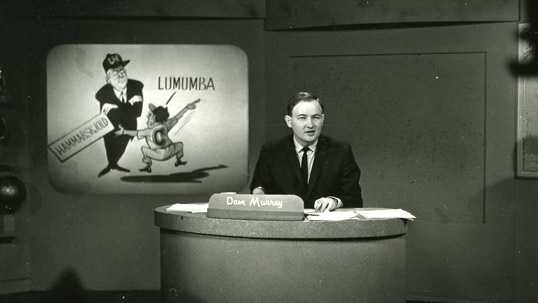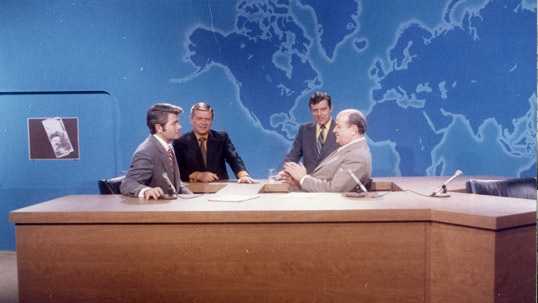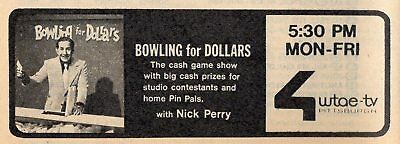WTAE at 62
September 14, 2020At age 62, WTAE is the youngest of the four VHF (analog, of course) stations in Pittsburgh. It took a while to get it on the air though because they had to decide who was going to get it and where they were going to put it.
Let’s begin in 1945 when Allegheny Broadcasting Corporation applied for the license – it would have placed the station on Channel 6 with transmission from Grandview Avenue at Shiloh Street. Allegheny had purchased KQV (1410) in 1944 and had the aforementioned property on Mount Washington. The AM signal was paired with WJAS on Crane Avenue in Banksville and although they didn’t get the license for TV, the Mt. Washington site was used for their FM allocation at 98.1 and later 102.5. (The AM would move to their 5 tower site in Ross Township in 1946. It was decommissioned just last year. The Mt. Washington site was later donated to WDUQ, now WESA 90.5)
In 1947, Allegheny Broadcasting requested a modification to their construction permit to change the frequency from Channel 6 to Channel 8. Neither made it to air as in 1948, the FCC put a halt on license awards until 1952. After this freeze and the realization that the VHF allocations would have to be shared with Wheeling and Steubenville (channels 7 and 9), Pittsburgh got three more VHF signals – 4, 11 and 13. We already had Channel 3 which was WDTV, and in 1953 DuMont sold it to Westinghouse on Channel 2 and that became KDKA-TV. The rest were on the unpopular UHF spectrum as most of the sets in those days didn’t pull anything above 13. Channels 6 and 8 would end up in Johnstown.
In 1954, when the permit for channel 4 opened, several operators went for it including the owners of WEDO (810 McKeesport). The station was to have been licensed to the Tube City, so that ownership would have made sense. Some had proposed the idea of licensing it to nearby Irwin, Westmoreland County. Either way, records show that an application had the transmitter co-located with WEDO on Foster Road in North Versailles. (Ironically that’s where the KQV-AM transmitter moved to in 2019!)
But despite several applications from various companies, it was Allegheny Broadcasting who again won the license. When a principal owner of KQV died, Hearst and others who lost out on the application petitioned the FCC to reconsider. This caused a stalemate between Allegheny Broadcasting and what seems to have been the strongest 2nd place winner, Hearst. Therefore the commission suggested a merger between Hearst and Allegheny Broadcasting. The two formed Television City, Inc. – the original licensee of WTAE – and it was now co-owned with Hearst’s WCAE-AM 1250, and a few years later, FM 96.1. Hearst’s involvement started their television portfolio along with Baltimore’s WBAL-TV. Allegheny Broadcasting meanwhile, sold KQV to ABC to appeal to ownership restrictions… which were really strict in those days. (The move was much like Pittsburgh Radio Supply House selling WJAS-AM/FM to NBC to be involved with the formation of WIIC-TV 11.) Hearst bought Allegheny Broadcasting outright in 1962.
The station would have likely been identified as “WTAE McKeesport-Pittsburgh” had Pittsburgh Mayor David L. Lawrence hadn’t pushed. It isn’t abundantly clear what processes took place to “influence” the city of license to be Pittsburgh, but the FCC had recently lifted restrictions so that the studios could be in Pittsburgh even if the license was McKeesport. Nonetheless, about 13 months before sign-on the construction permit was modified for the transmitter to go to Buena Vista (Elizabeth Township). Two months later the studio location was modified from McKeesport’s first ward to Wilkinsburg.



On September 14, 1958 WTAE signed on, just in time for Pittsburgh’s Bicentennial celebration that November. (The picture above with the construction worker was featured in the The Pittsburgh Bicentennial Magazine “Gateway Festival Edition”) No doubt the “T” was emphasized in the initial logo to signify that WTAE was the television sister to the radio station WCAE.
WTAE had a pretty small signal for the terrain. After all, our Channel 4 was “short spaced” to protect already-existing Channel 4s nearby – namely WLW-C in Columbus, Ohio (now WCMH). Also WOAY in Oak Hill, WV; WBEN-TV in Buffalo, NY (now WIVB); and WRC in Washington, DC (formerly WNBW). But the small signal was tough for many in Pittsburgh to receive and often Steubenville’s Channel 9 served the Pittsburgh area better from Altamont Hill.


Although Dave Murray and Carl Ide were household names in the late 1950s and early 60s, the team that put Channel 4 on the map was formed in 1969 by General Manager John G. Conomikes when he brought Paul Long over from KDKA to anchor the news. Long insisted they also bring meteorologist Joe DeNardo over from KD. They were teamed up with the new kid in town, Don Cannon as co-anchor. The team, initially with Ed Conway followed by a variety of sports anchors over the years, lasted until the mid-1980s when Long backed off for the Noon newscast and feature reporting before retiring in 1992.
WTAE was home to the nightly Pennsylvania Lottery Drawing until 1980 when a few employees – including well-known anchor Nick Perry – were involved in the infamous “6-6-6 Fix”. Perry and others fixed the numbers so that only the 6s would be drawn. He served jail time and a year later the drawing was moved to WHP in Harrisburg where witnesses watched each drawing.
Joe DeNardo and the station, with the help of the Salvation Army, started the Project Bundle Up clothing drive in 1986 and the tradition remains a tradition with the station.

Viewers no doubt remember shows like Bowling for Dollars hosted by Nick Perry. Children’s shows early on included Adventure Time with Paul Shannon and Ricki (Wertz) and Copper. Later Frank Cappelli produced a program with his music for children. AM Pittsburgh was a staple in the 70s and early 80s hosted by Lynn Hinds, Cathy Milton, and Al McDowell.
Channel 4 had a decent B-grade signal in the outlying markets like Johnstown and Steubenville making it the de facto ABC affiliate for those markets for many years. Eventually WATM in Altoona picked up the ABC affiliation, and WTRF, the CBS affiliate in Wheeling, picked up ABC for one of their digital subchannels recently. But WTAE still reaches both markets.

WTAE’s original digital allocation was 51 from its tower in Buena Vista. But again it was hard to push it over the terrain of the city from Southern Allegheny County. The FCC approved a repeater signal on Channel 22 (the former analog signal of what is now WPNT-TV) on WQED’s tower in Oakland. In the 2019 repack, the main digital signal is on Channel 27. One might think that since the digital conversion and because the channel isn’t short spaced anymore, the transmitter could be moved into the city. Then again, nevermind. With all the imperfections of digital, it might be less problematic to move the main transmitter!


But, before there was WATM in Altoona – the first solo ABC affiliate was long forgotten WOPC TV, broadcasting on Channel 38 from Wopsononock Mountain, hence the call letters. Stuck with an abysmal signal that cover much of Altoona not so much in Ebensburg or Tyrone, the station only lasted a few years before it wandered off to the night of the UHF Morgue. It’s broadcast day was from 3:00 to 11:00, except for Monday Night football, when the station shut down by itself and had to be manually restarted to finish showing the game. Ah, the good old days of Central Pennsylvania Television. While Channel 56 in Johnstown saved itself by moving down to Channel 19 (all analog), and Channel 8 came later, many people will remember the days of only channels 6 and 10, unless you were in State College, Loretto or up above 2,000 feet.
I concur on the signal. From our hilltop location in the South Hills WSTV and WTRF put a far better signal into our home than WTAE did in the pre-cable days. It was always wobbly, full of ghosts and static. A real annoyance whenever the Steelers played on Monday Nights.